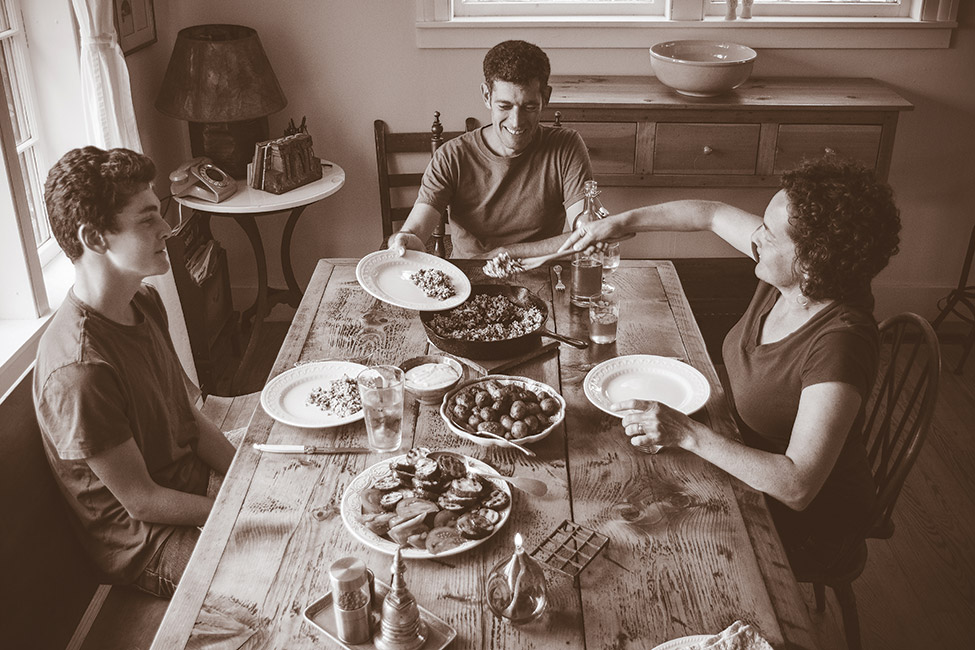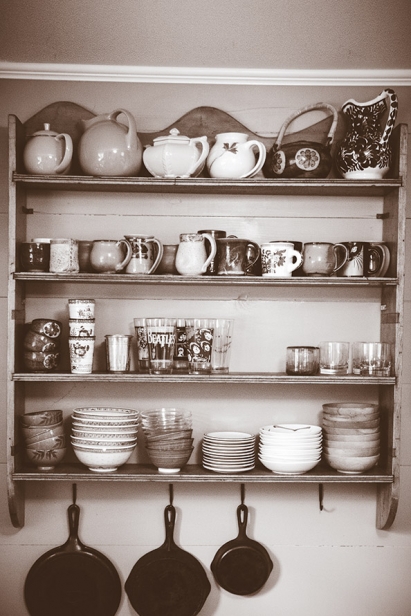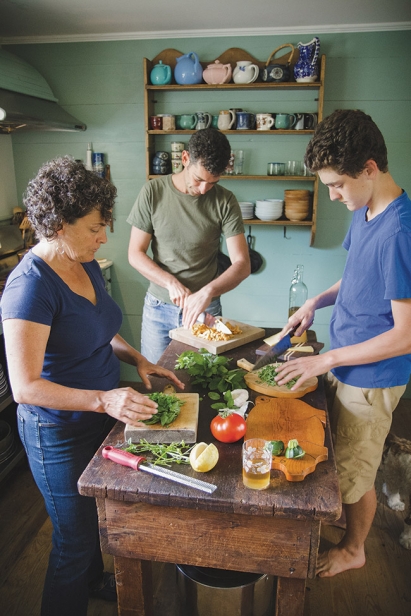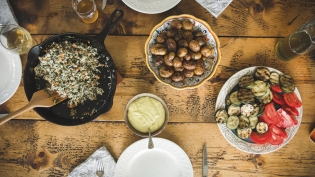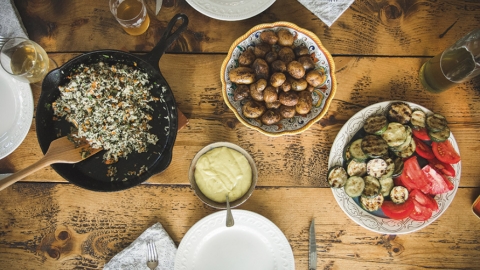Rowan and Mary Jacobsen
“Simple and strong on salt—use more salt than you think,” Rowan tells me. It’s Wednesday evening in the home of Rowan Jacobsen, one of my favorite food writers. We’re standing in the kitchen of their 1840s Cape, chatting about cooking. “In general,” Rowan continues, “most of the stuff you’re taught to feel bad about is actually fine. Fat is good for you, and salt’s not bad.” I feel better about my food choices already, so we’re off to a good start.
Rowan, his wife, Mary, and 16-year-old son Eric live in North Calais, on the edge of Vermont’s enchanting Northeast Kingdom. Surrounded by rising mountains and glittering lakes, their 4.5-acre property is dotted with century-old apple trees, wild mushrooms in maple woods and narrow trails. Their house is warm, light and decorated with Mary’s art—original woodprints made to illustrate texts on Western herbal medicine. There are also memorabilia from Rowan’s investigative trips around the globe, including a cast-iron press from Mexico that he uses to make tortillas and a wrought-iron teapot from Japan that he likes to brew a roast oolong iced tea in.
Rowan is a renowned James Beard Award–winning journalist whose books, including The Living Shore, Fruitless Fall and Apples of Uncommon Character, among others, are about everything food and the environment. Topics span from the restoration of the Colorado River and geography of oysters to sushi made with invasive species and much in between. His voice is educational, lyrical and down-to-earth. To use his own metaphor, Rowan’s writing process resembles hunting and gathering. And though Rowan is out looking for stories, not game, it’s easy to imagine him in the woods, too. A few years ago, he tried to break all 64 of Michael Pollan’s “food rules” (as described in Pollan’s Food Rules: An Eater’s Manual) in one day, but he failed, lured back to whole foods eating at the sight of wild dandelion, of all things. This occasion illustrates Rowan’s ambition, strong ideals and humor.
For the Jacobsen family, meals are deeply connected with season and place. In summer, Rowan and Eric canoe to a secret island to harvest chanterelles barefooted, with foraging baskets in arm, pocketknives in hand. The family picks wild herbs near home, such as the mint that grows in the creek out front. During the growing season the bulk of their produce is from High Ledge Farm, a CSA a mile up the road. When it’s warm out, they grill outside and then dine on their dock at Mirror Lake, a five-minute walk from their house. On occasion, they’ll picnic on their hand-built catamaran chasing the evening sun.
Preparing for the long winter, the Jacobsens bought a cow that had been causing trouble for a neighbor, Ben Hewitt, a well-known permaculturist, homesteader and author. “If you’re going to eat a cow, it’s the one to eat,” Rowan explains. He identifies as an “industrial vegetarian,” steers clear of factory-farmed meat and is intentional about the animals he consumes. He expects the family to take more than a year to get through this particular animal, as they savor every cut—chewy bits, scraps and all. When their CSA vegetables run out as winter approaches, they buy produce from Buffalo Mountain Coop, a member-owned nonprofit in Hardwick. The Jacobsen family transitions to one-pot meals: pot roasts, stews and ramen that are cooked in a Dutch oven atop their wood stove in the living room. To dine, they pull up small stools and sit to eat around this same fire that heats their house.
As Rowan, Mary and Eric prep dinner, they share a butcher block in the kitchen. Rowan crushes garlic, Mary pulls parsley leaves off their stems, and Eric slices squash into coins. Their late-fall “working-man’s risotto” with vegetables and aioli is in process. Aioli, a garlic-infused mayonnaise, is a staple for the family. It complements and adds salt, fat and flavor to so many foods: Mediterranean fish stew, grilled chicken and any kind of vegetable. While typically thought of as summer food, it’s also traditional on Christmas Eve in Provence, France, and works any time of year.
What sets Rowan’s aioli apart from the typical is the dollop of fish sauce he’s about to add. Fish sauce, he tells me, bottle in hand, “improves most everything.” Like soy sauce and oysters, fish sauce imparts umami, the so-called fifth taste, “the essence of deliciousness,” a savory, brothy, mouth-filling taste, as Rowan describes in the Art of Eating. “Everything?” I ask. “Pretty much. There aren’t many things that are worse with fish sauce…. Every stew or soup should have a little squirt. A glass of milk,” he jokes. Deeply respecting Rowan’s opinions around food, I almost believe him about the milk part.
Rowan didn’t come from a foodie family, nor was he particularly into food as a child (traits I can relate to). A self-taught cook, Rowan started experimenting with food in college after a semester in Italy. A few years later, he got a gig as a cook for a dude ranch in Wyoming, where he worked in the kitchen “14 hours a day, making buffalo stew for 50 people without any clue what I was doing.” It was trial by fire.
Rowan’s cooking is practical and fuss-free, and he says it’s gotten simpler over the years. As he writes in American Terroir, there are two traditions that run through gastronomy, and he is firmly in the “ingredient forward” camp in which the cook’s job is to “let the nature of the beast (or beet) shine through.” He has no interest in haute cuisine or fancy food with a focus on cooking as performance art. In the past Rowan relied on recipes but now never uses them. He also steers away from fancy gadgets. “Things don’t have to be as complicated as people make them,” says Rowan, who is crushing and peeling a clove of garlic. “I don’t think people should make a big deal out of cooking.”
The challenge with Rowan’s food-first approach to cooking, he says, is the widening gap between what he’d like to make and what his guests might like to eat. “I stopped wanting to make food delicious and just make it interesting,” he tells me. Rowan prefers that ingredients “be themselves” as much as they can, instead of relying on sugar and spices to mask flavor. His homebrewed cider, for example, made with apples from his land, is tannic, not sweet as you might expect. (For the record, it was delicious.)
“Cooking is a good focusing technique,” Rowan tells me, reflecting on their process of getting ready for tonight’s meal as we set the dining table. “It’s a good meditative discipline. It almost doesn’t matter what you’re cooking. Once it’s ready, the important part is done.” As Rowan’s preparation for dinner clarifies, creating a meal can be a medium to connect—with seasons, biology, each other, our values and ourselves. Making food allows us to spend time with company we want to keep and cultivate relationships with the community around us, human or nonhuman, animate and inanimate. When I get home, I’m going to let ingredients guide my dishes. I know I can’t go wrong with preparing fresh, seasonal food with fat, salt and a dash of fish sauce.
Hearing about the Jacobsens’ chanterelle expeditions reminds Vera Chang of mushroom hunting with her mother as a kid. They foraged for boletus, morels and chicken of the woods in New York forests.


